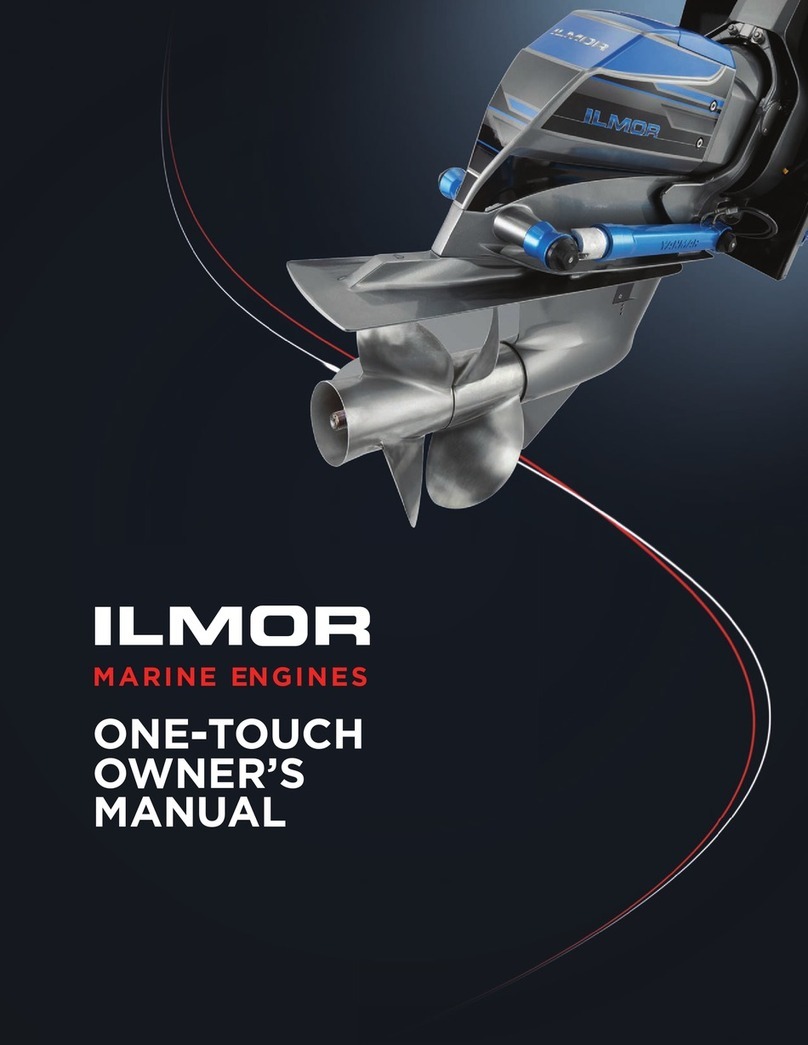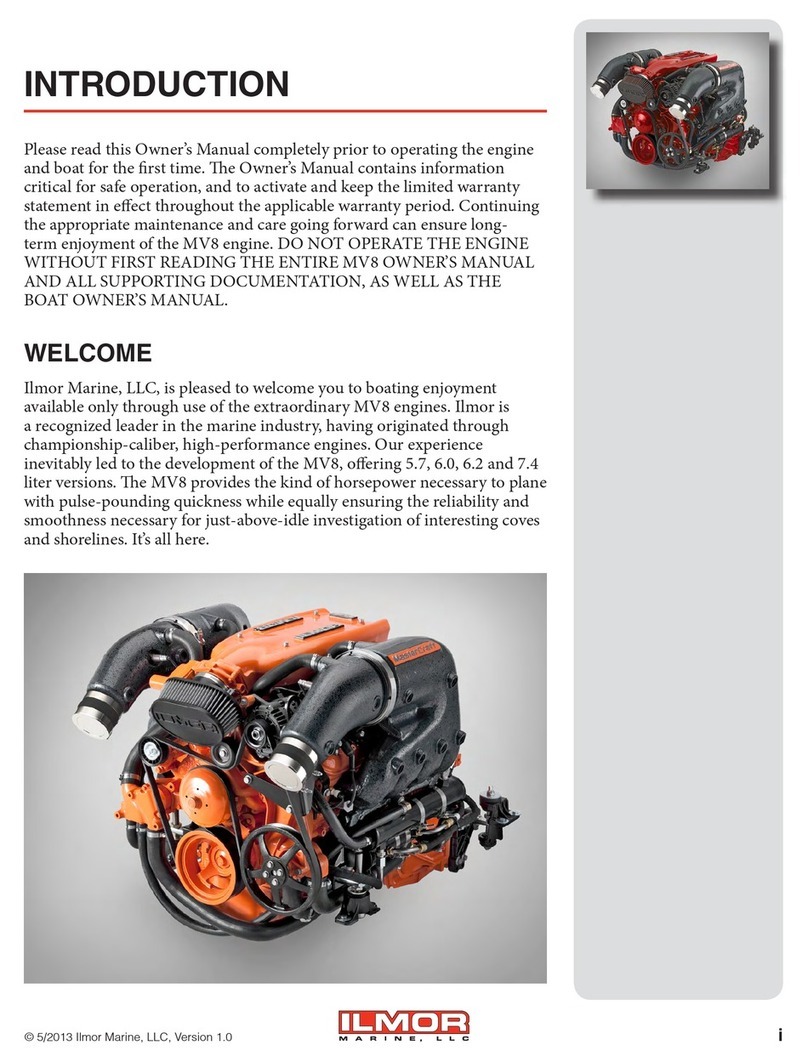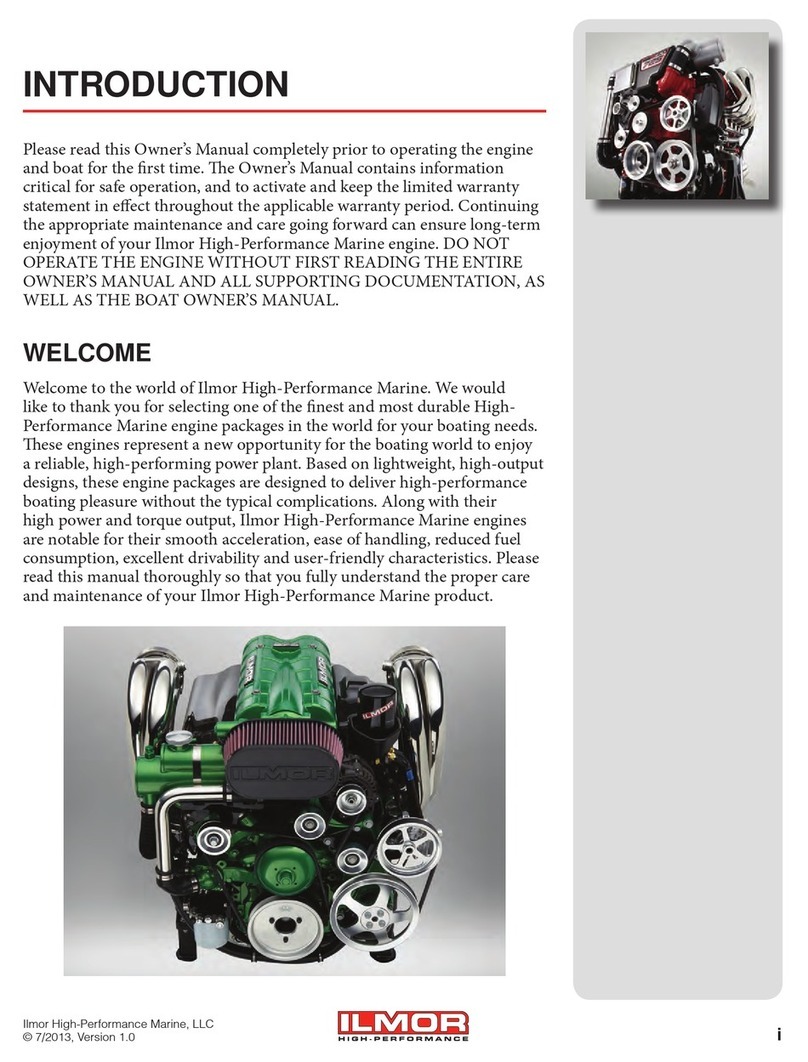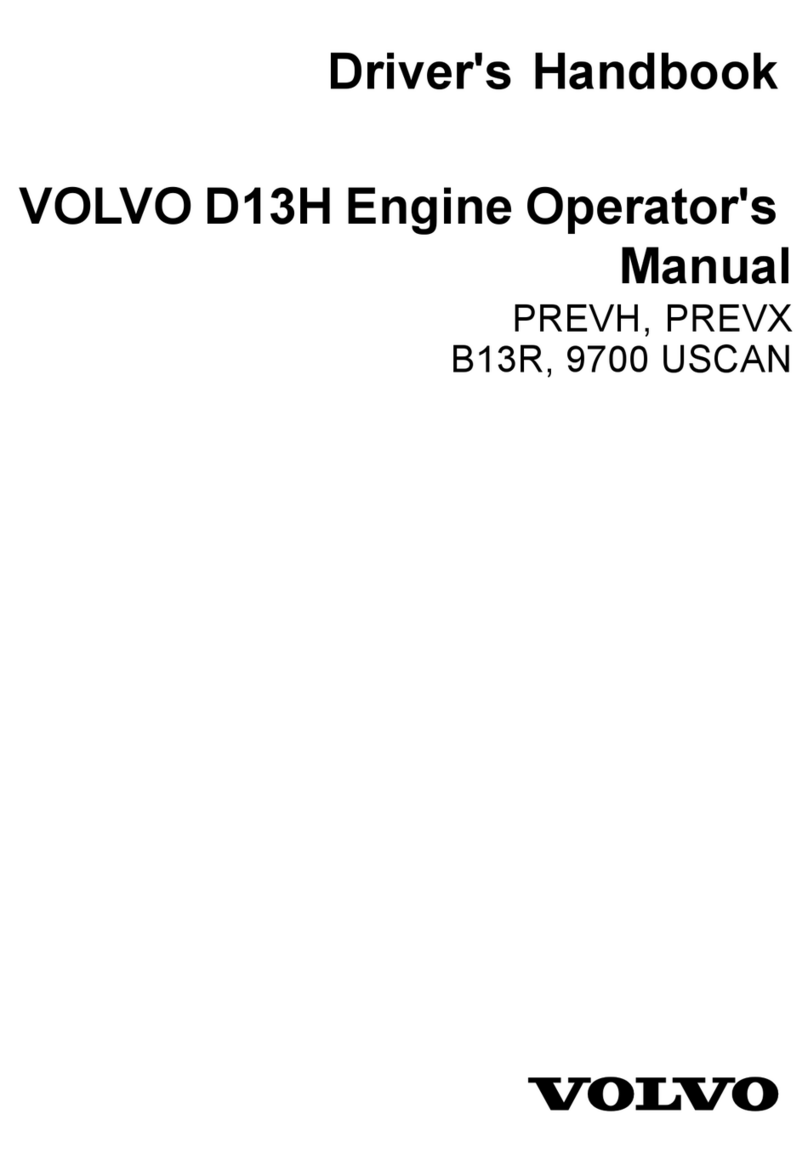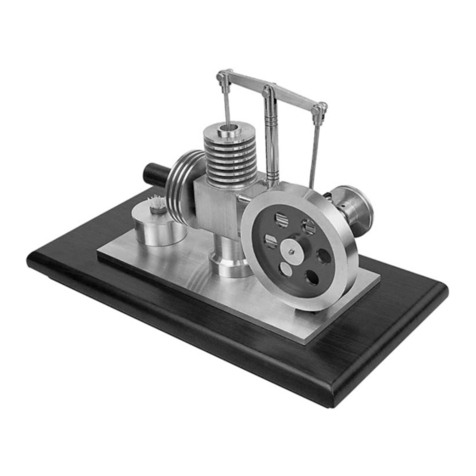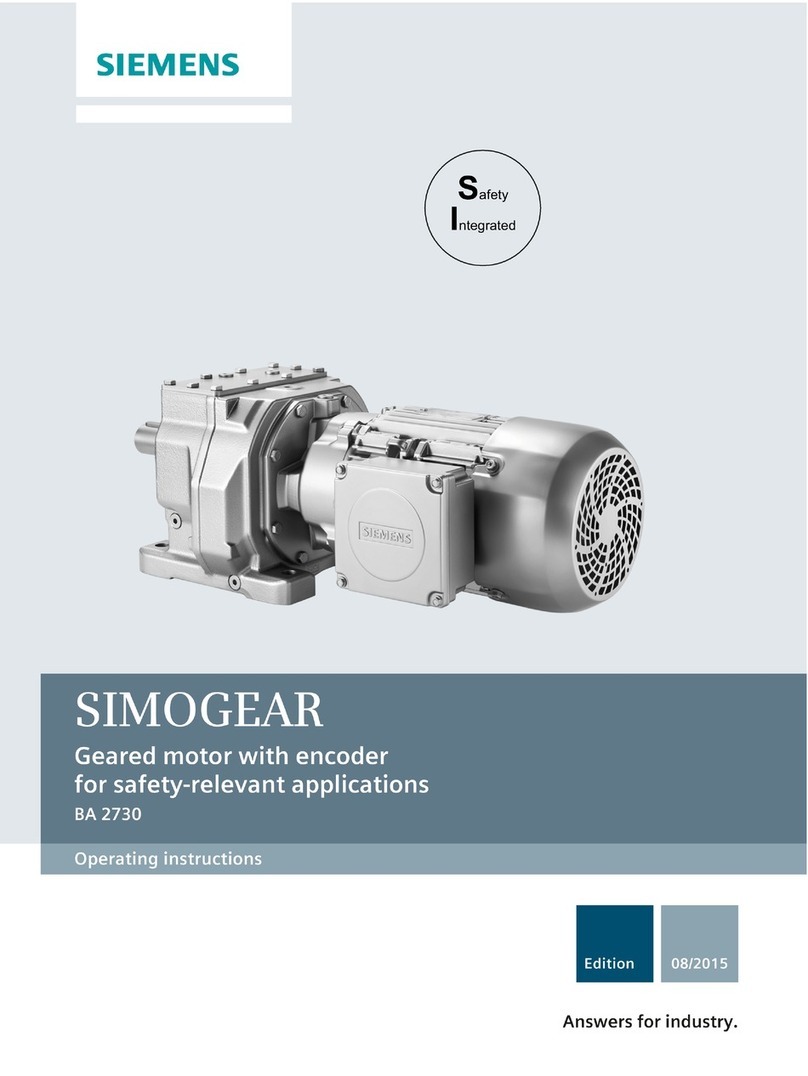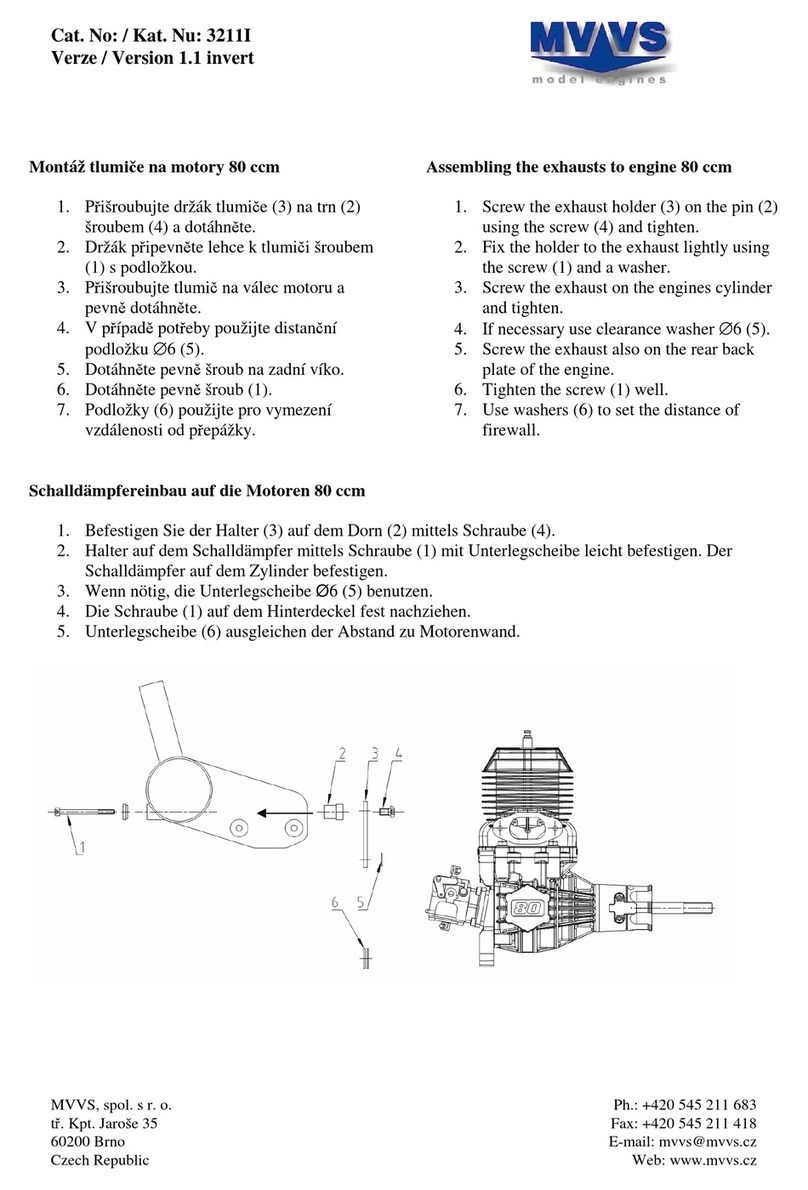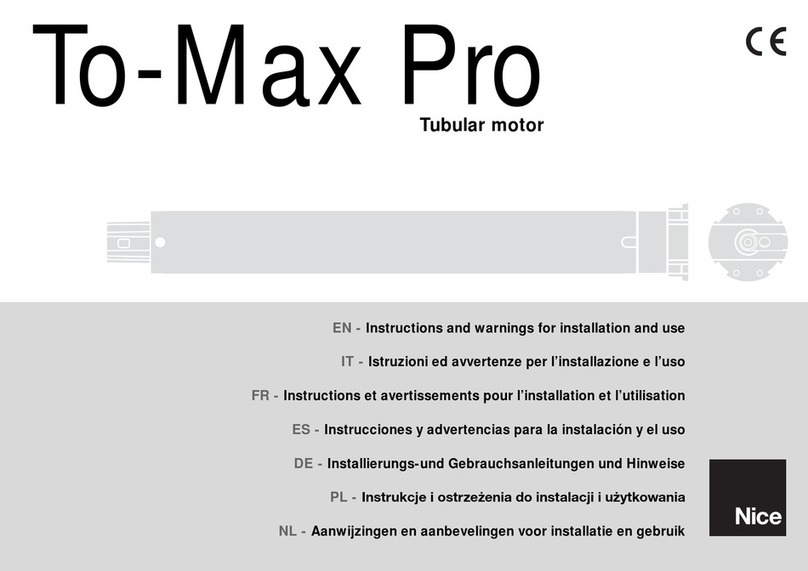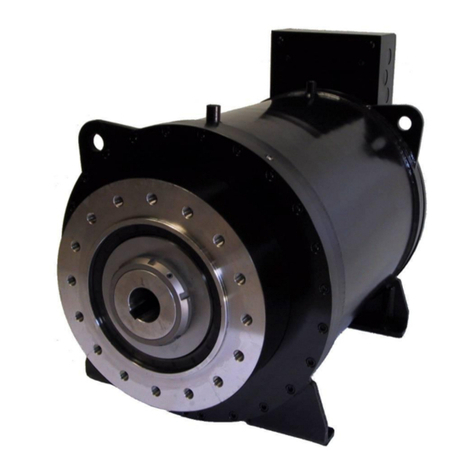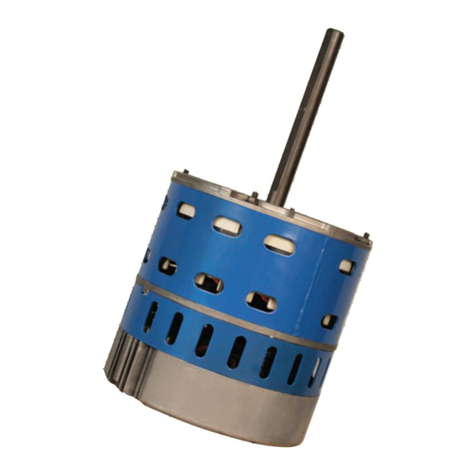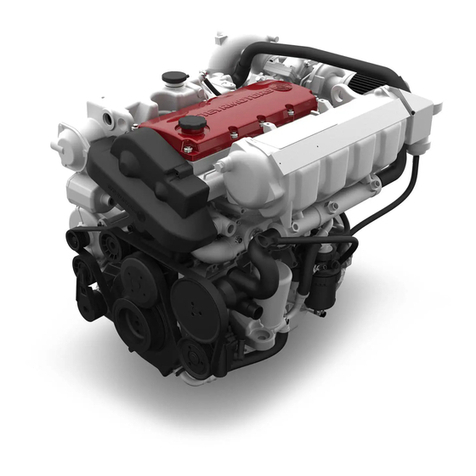ILMOR 2011 MV8 User manual

hour, and with equal execution when skiing at 30 mph. We didn’t leave out the simple joy of skimming across the surface from
10 mph to 45 mph with the same level of quality performance. The MV8 provides the kind of horsepower necessary to plane
with pulse-pounding quickness while equally ensuring the reliability and smoothness necessary for just-above-idle investigation
of interesting coves and shorelines. It’s all here.
The MV8’s heritage extends back to the company’s founding in 1983, when Swiss-born Mario Illien and British native Paul
Morgan sent a handwritten letter to American businessman and team owner Roger Penske. The duo proposed a new company
that would design and build turbocharged engines for race cars. Penske was intrigued and within three months ILMOR Engi-
neering was born.
Working with various international companies over the years, ILMOR has enjoyed unparalleled success in many forms of
racing, particularly Formula 1 and Indy Car racing. In fact, partnered with Honda, ILMOR is currently the sole provider of
engines to the Indy Car circuit.
Since 2004, ILMOR’s marine division has enjoyed
substantial growth, becoming a well-established sup-
plier in the U.S. and European high-performance boat
market. In addition to the MV-550 V-10 engine, ILMOR
has added two more packages: the MV-625 in 2005, and
the MV-710 in 2006. The 700-horsepower, naturally-as-
pirated marine engine was developed with significantly
improved fuel efficiency and a light-weight package, fac-
tors that would add to the superiority of the MV8 in its
development stage.
In 2009, ILMOR had to utilize its substantial engineer-
ing expertise to create an entirely new generation of MV-
10 marine products. Emissions requirements established
by the California EPA (the most stringent in the U.S.)
and the federal Environmental Protection Agency meant
that all high-performance marine engines had to meet
tough new exhaust emissions standards. The MV-650 and
the MV-725, along with state-of-the-art ILMOR elec-
ILMOR Marine, LLC, is pleased to welcome you to boating
enjoyment available only through use of the extraordinary MV8
engine. ILMOR is a recognized leader in the marine industry, hav-
ing originated through championship-caliber, high-performance
engines. Our experience inevitably led to the development of the
MV8, offering 5.7, 6.0 and 6.2 liter versions, which provide the
appropriate power range for ideal wakeboarding at 18 miles per
ILMOR MARINE
ILMOR MARINE
Please read this Owner’s Manual completely prior to operating the engine and boat for the rst time. The Owner’s
Manual contains information critical for safe operation, and to activate and keep the limited warranty statement in ef-
fect throughout the applicable warranty period. Continuing the appropriate maintenance and care going forward can
ensure long-term enjoyment of the MV8 engine. DO NOT OPERATE THE ENGINE WITHOUT FIRST READING THE ENTIRE
MV8 OWNER’S MANUAL AND ALL SUPPORTING DOCUMENTATION, AS WELL AS THE BOAT OWNER’S MANUAL.
WELCOME
2011 ILMOR MV8 Owner’s Manual • Page i

tronics and the all-new INDY® high-performance
stern-drive were created to not only meet but ex-
ceed every requirement of the new regulations.
In the first year of competition for the engines,
a pair of ILMOR Marine MV-10 625 engines pow-
ered the #99 Fountain Powerboat King of Shaves
to win the coveted 2007 Powerboat P1 Evolution
Class World Championship. The successful first year
of competition was backed up in 2008 with World
Championship wins in both the largely European-
based Powerboat P1 series and the U.S.-based APBA
P1 race series, and repeating in 2009 as Powerboat
P1 champion.
All of this rapid development with a genuinely
measured success has ensured that when ILMOR
created the MV8, the engine would do exactly what
it should do, right from the start. Everyone knows that creating horsepower is easy. Creating horsepower output in the correct
range for the correct application, however, is a challenge to which ILMOR was more than equal. You are about to benefit from
this knowledge and experience.
This Owner’s Manual reflects the most recent product information available at press printing. Nonetheless, ILMOR
retains the right to make changes to the engine and/or components as a result of continually improving the MV8. ILMOR
reserves the right to make changes to the engine specifications at any time, without prior notice, and to discontinue product.
Changes may be made without obligation on ILMOR’s part to provide or equip previously manufactured engines with updated
specifications. If the retail purchaser determines that updated equipment can be retrofitted on existing product, such changes
are at the sole discretion and cost to the retail purchaser. ILMOR bears no responsibility in these instances. Consumers are
encouraged to check www.ILMORMARINE.com regularly for additional information. The website will also track service bul-
letins and other technical information that may have impact on the consumer’s engine operation. ILMOR’s obligation regarding
such matters is delineated within the ILMOR Limited Warranty Statement, found within this Owner’s Manual.
Because of ILMOR’s commitment to continual product improvement, some alterations may occur to the current model MV8
after the publication of this Owner’s Manual. Realistically, this Owner’s Manual also cannot address every potential issue that may
arise from the operation and use of the MV8. A reasonable effort was made to make this Owner’s Manual as accurate and complete
as possible, but photographs and drawings may be only representational. Suppliers may also change or alter product. The informa-
tion provided discusses the topics and issues most critical to ensuring a successful, long-term ownership of the MV8 engine.
Most questions and discussions about the MV8 are best directed to your authorized ILMOR dealer. However, it may be
necessary or desirable to contact ILMOR directly. Please forward inquiries to the following:
ILMOR Marine, LLC
186 Penske Way
Mooresville, NC 28115
(704) 360-1900
Fax (704) 360-1901
Online contact: sales@ilmormarine.com
Product updates and technical bulletins: www.ilmormarine.com
ILMOR Marine would like to express appreciation to MasterCraft Boat Company for the loan of many photos that appear
within this manual.
2011 ILMOR MV8 Owner’s Manual • Page ii

DANGERS,
WARNINGS
& CAUTIONS
Throughout this manual the terms “Danger,” “Warning,” and “Caution” appear,
alerting the boat owner and/or operator to dangerous or potentially dangerous situations that
may arise. Those terms have the following respective meanings whenever they appear herein:
This is the safety alert symbol. It is used to alert you to potential personal
injury hazards. Obey all safety messages that follow this symbol to avoid
possible injury or death.
DANGER indicates an imminently hazardous situation which, if not avoid-
ed, will result in death or serious injury.
WARNING indicates a potentially hazardous situation which, if not avoid-
ed, could result in death or serious injury.
CAUTION indicates a potentially hazardous situation which, if not avoid-
ed, may result in minor or moderate injury.
CAUTION used without the safety alert symbol indicates a potential-
ly hazardous situation which, if not avoided, may result in property
damage.
Failure to adhere to and comply with the safety dangers, warnings and cautions that
appear in this manual can lead to serious illness, injury or even death and/or damage
to your boat or the property of others. Beyond these warnings, boaters have a personal
responsibility to utilize a common sense approach to the boating experience, including
keeping individuals off or near the swim platform and the stern area of the boat during
the engine operation. Personal flotation devices (“PFDs”) save lives and ensure positive
experiences. ILMOR offers many proactive approaches to the boating expe-
rience, but the consumer is ultimately responsible for the positive and safe
involvement in boating.
Be sure to review the Safety section of this manual, which immediately follows the Table
of Contents section. Because of the importance of these dangers, warnings and cautions,
they are reprinted here, along with the pages on which you will find them. Please note
that the safety information statements presented below are categorized for information
purposes only, and are not presented in any particular order of importance. Each of the
statements referenced below and in the other sections of this manual provide you with
important safety-related information and must be read and followed to avoid injury or
damage, as applicable. We strongly encourage you to cross-reference and read the dangers,
warnings and cautions within the context in which they are presented by reading and re-
viewing those sections.
2011 ILMOR MV8 Owner’s Manual • Page iii

Care must be taken to avoid exposure to carbon monoxide, even in small concentration.
Avoid exhaust areas and the engine compartment during the venting of engine exhaust.
Carbon monoxide is colorless, odorless and poisonous, and can cause serious injury or
death in short periods of time! (Page 2)
Gasoline is explosive. If a gasoline odor is present or if gasoline can be seen at any
point along the fuel line, the fuel tank, in the bilge or at the engine, DO NOT START THE
ENGINE! Remove the key from the ignition switch and call an authorized boat and/or
ILMOR dealer for service. Take care not to spill gasoline when fueling. If gas is spilled
accidentally, wipe up all traces with dry rags immediately and dispose of properly on-
shore. (Page 11)
Operate the bilge blower for at least four (4) minutes before starting the engine, and al-
ways when at idle or slow-running speed. Explosive gasoline and/or battery fumes may
be in the engine compartment. Failure to operate the bilge blower as directed may result
in explosion or re, resulting in serious injury or death. Always, before starting the engine,
open the engine compartment and check for fumes, leaks or the presence of uids in the
bilge. (Page 24)
The engine compartment serves as a machinery guard. The engine must be OFF whenever
the compartment is opened, except as directed by the boat manufacturer to vent exhaust
fumes or during maintenance. Use extreme care whenever operating the engine with the
compartment open. Clothing or body parts can get caught in moving parts, which could
result in serious injury or death. Keep away from rotating parts. Never attempt to stop or
slow rotating parts. (Page 2)
Use only genuine ILMOR Marine, LLC, replacement parts intended for the MV8 engine.
Many of the electrical and ignition components have been designed to comply with U. S.
Coast Guard regulations intended to minimize the possibility of re and/or explosion.
The use of non-approved replacement parts from aftermarket or other sources could re-
sult in re and/or explosion. This is not covered under warranty. (Page 2)
In the event that the fuel system supplying the MV8 engine requires attention, any adjust-
ment or replacement must be done by an authorized ILMOR dealer as the lines are pressur-
ized and can be disconnected only with specialized tools. Replacement of any part of the
fuel system must be with ILMOR-authorized parts only. Failure to follow this directive can
result in damage to the boat, which is not covered by the warranty, and/or serious injury or
death. (Page 6)
Any time the engine is running, an adequate amount of water as dened by ILMOR
Marine MUST be owing through the cooling system. This requires the boat to be in an
operational-sized body of water or hooked up to the suction side of a raw water pump
via an ILMOR-approved, water supply in a dealership. If the engine operates without
water in the cooling system, in very short order the exhaust system will overheat and could
potentially create an on-board re. The raw water pump impeller, which operates only
with water ow, will also fail. Damage caused to the boat under these circumstances is not
covered under warranty and could result in serious injury and/or death. (Page 6)
2011 ILMOR MV8 Owner’s Manual • Page iv

When connecting the battery cable, always connect the positive (+) battery cable rst.
After the positive cable is connected, then the negative (-) battery cable can be attached.
This minimizes the possibility of electrical contact. Always disconnect the negative battery
cable rst before disconnecting the positive battery cable. (Page 8)
Do not realign the wiring or in any way alter the wiring of the MV8 engine. Doing so may
result in damage to the engine, which is not covered under warranty, and sufcient volt-
age may be present to cause serious injury and/or death. (Page 9)
Careful inspection of the entire fuel system for leaks and/or deterioration must be part
of the maintenance of the engines prior to each outing. This inspection becomes even
more critical after substantial periods of non-use or storage. Be certain the inspection
includes the fuel tank, fuel lines, fuel pump, regulator, fuel rails, carbon canisters and all
ttings in the system. Any component that shows even slight signs of corrosion, leakage,
deterioration, swelling, hardening or softening should be brought to the attention of an
authorized ILMOR and/or boat manufacturer’s dealer for replacement prior to using the
boat. (Page 11)
Battery electrolyte uid is dangerous. It contains sulfuric acid, which is poisonous, cor-
rosive and caustic. If electrolyte is spilled or placed on any part of the human body,
immediately ush the area with large amounts of clean water and seek medical aid.
(Page 17)
When charging, batteries generate small amounts of dangerous hydrogen gas. This gas is
highly explosive. Keep all sparks, ames and smoking well away from the area. Failure
to follow instructions when charging a battery can cause an electrical charge or even an
explosion of the battery. This could result in serious injury or death. (Page 17)
When charging, batteries generate small amounts of dangerous hydrogen gas. This
gas is highly explosive. Keep all sparks, ames and smoking well away from the
area. Failure to follow instructions when charging a battery can cause an electrical
charge or even an explosion of the battery. This could result in serious injury or death.
(Page 19)
Any time the engine is running, an adequate amount of water as dened by ILMOR
Marine MUST be owing through the cooling system. This requires the boat to be in
an operational-sized body of water or hooked up to the suction side of a raw water
pump via an ILMOR-approved, water supply in a dealership. If the engine operates
without water in the cooling system, in very short order the exhaust system will overheat
and could potentially create an on-board re. The raw water pump impeller, which
operates only with water ow, will also fail. Damage caused to the boat under these
circumstances is not covered under warranty and could result in serious injury and/or
death. (Page 25)
Completely lling the fuel tank prior to storage and then sealing the fuel tank vent does
not allow room for necessary expansion. This can result, in extreme conditions, in fuel tank
rupture. Such release of fuel into the boat and potentially into the storage area could
result in substantial damage to the boat and contact with any spark (such as a ame-
producing pilot light in a heater) could also result in property damage and serious injury
or death. (Page 38)
2011 ILMOR MV8 Owner’s Manual • Page v

Excessive exhaust temperatures will damage the exhaust hose and are symptomatic of a
leak or restriction in the cooling system. The engine should be shut OFF immediately in the
presence of too much heat, whether by odor, touch or sight. Failure to do so may result
in more serious consequences, including but not limited to, damage to the engine, which
is not covered under warranty, and/or damage to the boat that may result in personal
injury as well. (Page 5)
Always be certain that there is ample room around the boat when trying to start the engine
in forward position as the boat will move forward when the engine starts. Contact with other
boats, docks, shallow waterway bottoms, or debris may result in damage to the boat that is
not covered under warranty, and may also result in serious injury. (Page 26)
Boats are equipped with a variety of audible and visual alarms that alert operators to
potential performance issues. No alarm, whether it sounds an alert or provides informa-
tion on the gauges, should ever be ignored. The drive train’s sensors are often the earliest
indication of problems that, if ignored, may result in serious damage to the equipment.
This is not covered under warranty. (Page 10)
Damage to the engine by use of low-quality gasoline or gasoline with an octane rating
below the minimum level listed for ILMOR MV8 engines will void the warranty on the
engine. (Page 12)
Extended storage with fuel in the system can affect fuel stability and may require system
inspection and fuel lter replacement when the boat returns to service. (Page 12)
Damage to the engine by use of low-quality or non-specied oil as listed for ILMOR MV8
engines will void the warranty on the engine. (Page 13)
Damage to the engine by use of low-quality or non-specied transmission uid/oil as listed
for V-Drive and direct drive transmissions will void the warranty. Overll or underll may
also result in serious damage to the engine and is not covered under warranty. (Page 13)
Ignoring elevated temperatures on a temperature gauge or any other evidence of the engine
operating at temperatures above recommended levels can result in serious damage to the
engine. Any resulting damage will not be covered by the warranty. (Page 14)
Failure to maintain your coolant at the proper level will cause potentially serious engine
damage. The warranty does not cover engine damage due to overheating or any other
cause associated with improper coolant levels. (Page 16)
Add-on equipment may adversely affect the alternator output or overload the electrical
system. Any damage caused as a result will not be covered by the warranty. (Page 17)
Failure to follow the break-in and operating procedures as described in this Owner’s Manual
will void the warranty. Before operating the boat for the rst time, you must read this Owner’s
Manual completely, as well as the boat manufacturer’s Owner’s Manual. (Page 23)
2011 ILMOR MV8 Owner’s Manual • Page vi

Boat owners should not remove the factory break-in oil until after a minimum of ten (10)
hours proper operation, but not later than twenty-ve (25) hours. At that time, an oil
change should be performed by an authorized ILMOR dealer, who will be able to “read”
the oil and lter to determine if the proper break-in of the engine components appears
to be occurring. (Page 23)
Failure to follow the engine oil recommendations listed in the manual can cause accelerated
engine wear and could result in component failure. Damage to the engine due to incorrect
oil usage, oil changes and correct levels may void the warranty. (Page 24)
Never operate the starter motor continuously for more than fteen (15) seconds without at
least two (2) minute resting intervals. Failure to do so may result in the starter overheating,
which is damage not covered under warranty. The ignition key must be released after the
engine has started to avoid damage to the starter motor and drive. (Page 26)
When moving between forward-neutral-reverse or any combination of gear settings, al-
ways all the engine to fall to idle (600-800 RPM) before completing the shift. Failure to do
so may result in damage that is not covered under warranty. (Page 26)
Failure to follow the engine oil recommendation listed in this Owner’s Manual can result
in exaggerated engine wear and increase the possibility of engine component failure.
Damage to your engine due to failure to follow engine oil procedures can be costly to
repair and is not covered under warranty. (Page 30)
Ignoring elevated temperatures on a temperature gauge or any other evidence of
the engine operating at temperatures above recommended levels can result in serious
damage to the engine. Any resulting damage will not be covered by the warranty.
(Page 33)
Exposure to salt water causes corrosion, leading to signicant damage to metal, including
stainless steel and chrome. If evidence of corrosion shows on the boat, the engine and
transmission should be carefully cleaned with fresh water and a mild soap solution after
use in salt water. A protective marine oil may be applied to exposure metal to halt the
acceleration of corrosion. Failure to pay attention to corrosion matters will void the war-
ranty. (Page 36)
Damage due to improper storage and/or winterization preparations is not covered un-
der warranty. Owners are encouraged to seek assistance from an authorized ILMOR
dealer to properly prepare the drive train for periods of inactivity exceeding two (2)
weeks. (Page 37)
Fuel systems on all boats equipped with ILMOR MV-8 engines MUST be properly pre-
pared for storage periods exceeding two (2) weeks, as outlined in this Owner’s Manual.
Failure to do so will void the warranty. (Page 38)
2011 ILMOR MV8 Owner’s Manual • Page vii

TABLE
OF
CONTENTS
Safety ................................................................................................. 1
Direct Safety Concerns .......................................................................... 2
Introducing the MV8 ........................................................................... 3
Exhaust System ................................................................................... 5
Fuel System ........................................................................................ 5
Cooling System ................................................................................... 6
Open Cooling System ........................................................................ 7
Full Closed Cooling System ................................................................. 7
Electrical System ................................................................................. 8
Fuse Box ........................................................................................ 8
Boat/Engine Interfacing Wiring ............................................................ 9
Engine Sensors .................................................................................... 9
Alarms .............................................................................................. 9
Water Temperature ............................................................................ 9
Oil Temperature ..............................................................................10
Oil Pressure ...................................................................................10
Fueling the MV8 .................................................................................11
Fuel Requirements ..............................................................................11
Oxygenated Gasoline or Gasoline Containing Alcohol ................................12
When the Boat Is Not Used in a While ....................................................12
Fuels Outside the United States and Canada ............................................12
Other Pre-Outing Requirements ..........................................................13
Engine Oil ........................................................................................13
Transmission Fluid/Oil .........................................................................13
Before Each Use .................................................................................14
Check the Raw Water Impeller/Sea Pump ..................................................14
Check the Transmission Cooler ...............................................................15
Check the Coolant Level .......................................................................15
Check the Alternator Belt for Looseness or Damage ......................................16
Inspect the Battery Connections and Hold-Downs ........................................16
Inspect the Engine for Loose or Missing Hardware........................................17
Inspect the Fuel and Exhaust Systems for Leaks ...........................................18
Inspect the Throttle & Shift Cables for Kinks, Wear & Interference ....................18
Check that the Battery Is Fully Charged .....................................................18
Check the Transmission Fluid/Oil Level ....................................................19
Check the Engine Oil Level ...................................................................20
After Each Use ...................................................................................21
Check Raw Water Pick-up .....................................................................21
Flush Raw Water/Sea Pump System .........................................................21
Check for Leaks .................................................................................22
Clean Any Residue ..............................................................................22
Starting, Stopping and New Engine Break-In ........................................23
First Hours of Operation ......................................................................24
After Initial Hours of Operation ..............................................................24
Before the Engine Is Started ...................................................................24
Starting the Engine ..............................................................................25
2011 ILMOR MV8 Owner’s Manual • Page viii

Shifting Gears ....................................................................................26
Stopping the Boat ................................................................................26
Other Considerations ...........................................................................27
Maintenance......................................................................................28
Change the Engine Oil & Filter ...............................................................28
Change the Transmission Fluid/Oil & Filter ................................................30
Clean the Engine Flame Arrestor/Air Filter ................................................31
Replacing the Raw Water Impeller/Sea Pump Impeller ..................................32
Raw Water (Sea Water) Draining and Filling ................................................33
Coolant Draining (Changing Coolant) and Filling .........................................34
Flush Coolers ....................................................................................35
Replacing the Serpentine Belt .................................................................35
Replacing the Zinc Anodes (Saltwater Applications) ......................................36
Cleaning Engine Compartment and Corrosion Prevention ..............................36
Engine Tune-Up .................................................................................36
Storage and Winterization ...................................................................37
Fuel System Treatment .........................................................................37
Oil Storage/Winterization ....................................................................38
Cooling System Storage and Winterization .................................................38
Method 1-Engine Off ........................................................................39
Method 2-Engine On ........................................................................40
Engine Fogging Oil..............................................................................40
Battery Winterization ...........................................................................40
Recommissioning After Storage/Winterization ............................................41
Emissions...........................................................................................42
Emissions Control Information Label ........................................................42
Emissions Control System Information ......................................................42
Star Label .........................................................................................42
Hang Tag ..........................................................................................43
On-Board Diagnostics-Marine (OBD-M) ...................................................43
California and U.S. EPA Emissions Control Warranty Statement ....................44
Your Warranty Rights and Obligations ...................................................44
Manufacturer’s Warranty Coverage .......................................................44
Owner’s Warranty Responsibilities ........................................................44
General Emissions Warranty Coverage ...................................................44
Emissions Control System Warranty Parts ...............................................45
Troubleshooting.................................................................................47
ILMOR Marine LLC Limited Product Warranty .....................................48
Specifications and Service Log .............................................................53
Engine Specs .....................................................................................53
Requirements & Recommendations ......................................................53
Maintenance Requirements.................................................................54
Service Log ....................................................................................55
Index ................................................................................................56
2011 ILMOR MV8 Owner’s Manual • Page ix

Safety is paramount to ILMOR. Every reasonable effort has been made to provide
directions to safe and thoughtful use of the ILMOR product. In most instances, adherence
to common sense when operating or working around the engine will present the boat op-
erator, all on board and other boaters on the same body of water, the proper atmosphere
in which to safely enjoy the experience.
Prior to operating the boat for the first time, boat operators MUST read
this Owner’s Manual in its entirety. It is also recommended to re-read it prior to the
first outing each boating season. Keeping the Owner’s Manual on-board the boat in
a dry, secure location such as a glove box, is highly recommended for referral pur-
poses. Be sure to also read the boat Owner’s Manual, with particular attention to
proper operation and safety concerns addressed within that publication.
It is the boat owner’s and the operator’s responsibility to be aware of safety issues
and concerns in the proper operation of the boat. All people on-board, regardless of
age, physical limitations and/or previous boating experience (or lack of experience),
bear responsibility for determining the appropriate behavior and safety precautions,
including care around the engine, engine box, transmission and all moving parts.
Key to safety is the prescribed maintenance of the engine and drive train as de-
scribed in this Owner’s Manual, on www.ILMORMARINE.com, and through in-
formation and directives provided by the suppliers of parts for the drive train. A
properly prepared and maintained engine is less likely to stall, misfire or otherwise
operate in a manner that could place the boat occupants, as well as others on the
same body of water, in unsafe situations.
Throughout the MV8 Owner’s Manual, specific safety information will be high-
lighted with symbols designed to draw particular attention to specific information.
These will include:
The safety alert symbol, is used to alert to potential personal injury hazards. Obey
all safety messages that following this symbol to avoid possible injury or death.
DANGER indicates an imminently hazardous situation that will result in death or
serious injury if not avoided.
WARNING indicates a potentially hazardous situation that could result in death or
serious injury if not avoided.
CAUTION indicates a potentially hazardous situation that may result in minor or
moderate injury if not avoided.
CAUTION used without the safety alert symbol indicates a potentially hazardous
situation that may result in property damage if not avoided.
The precautions listed in this Owner’s Manual are not all-inclusive. ILMOR cannot
anticipate any or all safety issues, nor fully anticipate the extent to which injury may occur.
Information contained in this Owner’s Manual reflects a consensus of opinion within the
marine industry.
2011 ILMOR MV8 Owner’s Manual • Page 1
SAFETY

Whenever an MV8 engine is operated within the confines of an engine compartment,
it is extremely important to follow the boat manufacturer’s instructions regarding venting
of the engine compartment prior to or during low-speed/idle operation. Exhaust fumes
may build up inside the engine box, which can, and has, resulted in explosions.
One of the most critical safety matters affecting boaters is the matter of carbon mon-
oxide emission. This is a colorless, odorless and poisonous gas that accumulates rapidly,
both within confined areas and even within the open air. Exposure to carbon monoxide
can be fatal within minutes, even in low concentrations. Avoid exhaust vent areas of the
boat, particularly during slow-speed operation.
Care must be taken to avoid exposure to carbon monoxide, even in small concentra-
tion. Avoid exhaust areas and the engine compartment during the venting of engine
exhaust. Carbon monoxide is colorless, odorless and poisonous, and can cause seri-
ous injury or death in short periods of time!
All persons on-board must exhibit special care and concern whenever the engine is
running and the engine compartment is open. Everyone should avoid all moving parts. If
the engine or anything accessible from the engine compartment requires adjustment while
the engine is running, the adjustment should be done by an authorized ILMOR dealer or
authorized boat manufacturer dealer if at all possible. If adjustments are necessary while
the boat is underway or in preparation for boating, extreme care should be used.
The engine compartment serves as a machinery guard. The engine must be OFF
whenever the compartment is opened, except as directed by the boat manufacturer
to vent exhaust fumes or during maintenance. Use extreme care whenever operat-
ing the engine with the compartment open. Clothing or body parts can get caught in
moving parts, which could result in serious injury or death. Keep away from rotating
parts. Never attempt to stop or slow rotating parts.
It is the owner’s and/or operator’s responsibility to perform all safety checks to the
engine(s) prior to, during and after operating the boat. When properly adhered to, the main-
tenance schedules listed in this Owner’s Manual will ensure long-term operation and perfor-
mance of the engine. When service and maintenance are required, return the boat to an autho-
rized ILMOR dealer. Failure to follow procedures outlined in this Owner’s Manual or through
published technical information at www.imormarine.com may void the warranty.
The precautions listed in this Owner’s Manual, as well as published technical infor-
mation are not all-inclusive. Any replacement part, fluid or substance that is not specified
as recommended should not be used as it may result in engine failure. This could lead to
voiding the warranty, as well as placing people in an unsafe situation.
Use only genuine ILMOR Marine, LLC, replacement parts intended for the MV8 en-
gine. Many of the electrical and ignition components have been designed to comply
with U. S. Coast Guard regulations intended to minimize the possibility of re and/or
explosion. The use of non-approved replacement parts from aftermarket or other
sources could result in re and/or explosion. This is not covered under warranty.
Direct Safety Concerns
2011 ILMOR MV8 Owner’s Manual • Page 2

INTRODUCING THE MV8
INTRODUCING THE MV8
2011 ILMOR MV8 Owner’s Manual • Page 3

2011 ILMOR MV8 Owner’s Manual • Page 4
Use photos or drawings as necessary
to designate important components,
including interal; allow two pages for
these.
IGNITION COIL AND
REAR ACCESSORY BRACKET
NEUTRAL SAFETY SWITCH
AT TRANSMISSION
THERMOSTAT LOCATION
CRANKSHAFT DAMPER
EXHAUST MANIFOLD
DRAIN PLUG
ENGINE CONTROL MODULE
ENGINE OIL
FILTER LOCATION
ENGINE O2 SENSOR

2011 ILMOR MV8 Owner’s Manual • Page 5
ILMOR MV8 engines are equipped with “wet” marine exhaust systems. In
a wet marine exhaust system, raw water enters the exhaust elbows (also referred to as
“downturn adapters”), where it mixes with the exhaust gases. The mixing of the water and
exhaust gases is important because it provides cooling to the rubber hose that connects
the exhaust elbow to the muffler. After the water-exhaust gas mixture passes through the
mufflers it exits back into the body of water.
Water-exhaust gas mixture temperatures will be less than 250 F. (121 C.) If the tem-
peratures are greater than that, the rubber exhaust hose will burn. If the hose has an odor
of burning rubber, immediately shut down the engine. Check for leaks or restrictions in
the cooling system.
Excessive exhaust temperatures will damage the exhaust hose and are symptomatic
of a leak or restriction in the cooling system. The engine should be shut OFF imme-
diately in the presence of too much heat, whether by odor, touch or sight. Failure to
do so may result in more serious consequences, including but not limited to, damage
to the engine, which is not covered under warranty, and/or damage to the boat that
may result in personal injury as well.
The exhaust manifolds are water-cooled. Water temperatures in the exhaust
manifolds range from 158 F. to 194 F. (70 C. to 90 C.) The ILMOR exhaust mani-
fold water temperatures are approximately 50-66 per cent warmer than exhaust
manifolds on engines without catalytic converters. If the engine exhaust manifold
temperature reaches 199 F. (93 C.) in an open cooled engine or 239 F. (115 C.)
in a closed cooled engine, the system is malfunctioning, and as with the situation
involving the hoses explained above, the engine should be shut OFF. Check the
cooling system for leaks or restrictions. It will not be unlikely that overheating will
affect both the manifolds and hoses, as a symptom of cooling system problems.
The MV8 exhaust hose meets SAE J2006 and ABYC Standards. These hoses
function properly in conditions up to 250 F. (121 C.)
ILMOR engines are equipped with a catalytic converter system. This allows
ILMOR marine engines to earn a Four-Star emissions rating and comply with the
California Air Research Board (CARB) rules. The catalyst bricks are press fit into
one-piece exhaust manifolds. If needed, the catalyst bricks can be removed and
replaced within the original exhaust header. However, a special tool is needed to
remove the catalyst brick and install a new one. ILMOR strongly recommends that
this function be performed by an authorized ILMOR dealer.
See additional important information in the Emissions chapter of this Owner’s Manual.
ILMOR’s MV8 engine is equipped with the fifth generation Marine Electronics
Fuel Injection (MEFI-5) system, the most up-to-date system available in the industry. The
MEFI-5 is an advanced engine controller that is capable of meeting all emission, On-Board
Diagnostics Marine (OBD-M) and driveability requirements of marine applications.
All fuel system lines and connections must meet the requirements of U.S. Coast Guard
(USCG) regulations. This means that hoses must meet or exceed SAE Standard J1527 DEC85,
and hoses used for fuel delivery must meet or exceed specification in USCG regulations, Sec.
183.540 for recreational boating. Additionally, all fuel hose must meet the 15g/m^2 limit
for fuel permeation. All plumbing for the fuel system on ILMOR engines, and the boats in
which ILMOR authorizes placement, meet or exceed all requirements. See also Fueling the
MV8 chapter of this Owner’s Manual for additional information.
EXHAUST
SYSTEM
FUEL
SYSTEM

COOLING
SYSTEM
In the event that the fuel system supplying the MV8 engine requires attention, any ad-
justment or replacement must be done by an authorized ILMOR dealer as the lines are
pressurized and can be disconnected only with specialized tools. Replacement of any
part of the fuel system must be with ILMOR-authorized parts only. Failure to follow
this directive can result in damage to the boat, which is not covered by the warranty,
and/or serious injury or death.
Unlike automotive cooling systems that use radiators (air-to-fluid
heat exchangers) for cooling, marine engines use fluid-to-fluid heat exchangers. Cooling
is provided by the body of water in which the boat is operated. A raw water pump (rubber
impeller pump) draws water into the boat where it is distributed to the engine, exhaust
system, and heat exchangers for maintaining the engine at an acceptable heat-operating
temperature range.
There are two main types of cooling systems used in ILMOR engines, one of which
will be found with each engine depending upon the type selected:
1. OpenCoolingSystem
(Raw water from a body of water flows through the engine and exhaust manifolds.)
2. Full-ClosedSystem
(Engine coolant flows through the engine and exhaust manifolds.)
Any time the engine is running, an adequate amount of water as dened by ILMOR
Marine MUST be owing through the cooling system. This requires the boat to be in
an operational-sized body of water or hooked up to the suction side of a raw water
pump via an ILMOR-approved, water supply in a dealership. If the engine operates
without water in the cooling system, in very short order the exhaust system will
overheat and could potentially create an on-board re. The raw water pump impel-
ler, which operates only with water ow, will also fail. Damage caused to the boat
under these circumstances is not covered under warranty and could result in serious
injury and/or death.
Ensure that the raw water pick-up remains clear of debris at all times. Even
small amounts can clog or block the pick-up, which is located beneath the boat.
The raw water pick-up MUST have an uninterrupted input of water whenever
the engine is running.
Importantnote:marinegrowthoccursinbrackishandsaltwater,and
eveninwhatisreferredtoas“fresh”orsalt-freewater.Therefore,itisim-
portanttoushtheboat’scoolingsystemwithfreshwateraftereachuse.
Accelerated marine growth occurs when operated in salt water. This makes
it critical to flush the cooling system with fresh water after each use. This fresh
water flushing can be done with the boat either in or out of the water. Instruc-
tions for accomplishing this are provided in the After Each Use chapter of this
Owner’s Manual.
Although ILMOR MV8 engines are capable of operation in salt water, if the boat
will be most frequently used in salt water a closed cooling system is recommended.
2011 ILMOR MV8 Owner’s Manual • Page 6

The open cooling system was designed primarily for fresh water use
only. Whenever the boat is operated in brackish or salt water, particular care, without fail,
must be taken to flush the system with fresh water after every use. However, even if boating
in salt-free, apparently clean fresh water, flushing the cooling system following use is recom-
mended. This helps eliminate marine growth or fouling of the cooling system.
2011 ILMOR MV8 Owner’s Manual • Page 7
Open Cooling System
Full Closed
Cooling System
In an open cooling system, raw water is drawn into the
boat by the raw water pump. (The intake is on the back of
the boat where it will be submerged and can draw water
continuously; the pump is located on the engine block.)
When the engine is cold, or the operating temperature
remains below 170 F. (76 C.), minimal water flows through
the engine and exhaust manifolds. All excess water will exit
into the exhaust manifold’s down-turn adapters to cool the
marine rubber hoses for the wet exhaust system. Through
the exhaust, the water returns to the body of water.
When the engine is warm, with an operating tem-
perature greater than 170 F. (76 C.), the water from the
raw water pump feeds the engine recirculation pump.
The recirculation pump pushes water through the engine
block, cylinder heads and exhaust manifolds. When the
water mixes with the exhaust gases in the exhaust down-
turn adapters, it then returns to the body of water.
The full closed cooling system is the best application for boats operating in consistently
brackish or salt water. The system provides maximum protection for the engine against
corrosion, fouling and marine growth. As noted above, it is extremely important to keep
the system flushed after each use.
In a full closed system raw water is drawn into the boat by the raw water pump,
where it is distributed to the heat exchangers and then to the exhaust down-turn adapt-
ers before being returned to the body of water. The engine recirculation pump re-
circulates coolant through the engine and exhaust manifolds. Raw water never enters the
engine or exhaust manifolds.

2011 ILMOR MV8 Owner’s Manual • Page 8
ELECTRICAL
SYSTEM
The electrical system on the MV8 is a 12-volt negative ground system. As
a result, it is important to keep in mind that operators must avoid reverse polarity, which
could lead to extensive damage of the electronics. Any damage occurring as a result of
reverse polarity will not be covered by warranty.
Reversed polarity also presents a serious shock risk. Turning off a breaker appears to
remove power from the circuit because it turns off whatever is connected to that circuit.
But with reversed polarity you have disconnected from ground, not from power. The
circuit is live!
When connecting the battery cable, always connect the positive (+) battery cable
rst. After the positive cable is connected, then the negative (-) battery cable can be
attached. This minimizes the possibility of electrical contact. Always disconnect the
negative battery cable rst before disconnecting the positive battery cable.
The battery positive cable (+) connects
at the starter motor battery post.
The battery negative (-), or ground,
connects to the stud at the engine bell-
housing.
The positive post of the battery is connected to
the large post provided on the starter motor with
marine grade single ought (1/0) starter wire and
appropriate eyelet. After the connection is made, all
other positive engine circuits will be connected to
the battery positive from this junction. The supplied
heavy rubber boot (red) must be used on the starter
motor terminal to shield the terminal and prevent
accidental contact.
In addition to circuit breakers in the boat that may impact the engine
functionality or ancillary equipment and electronics that borrow power from the engine,
the engine is also equipped with a fuse box that adds control over various electronic func-
tions of the engine. The fuse box is mounted on the rear of each MV8 engine.
Fuse Box

The electrical system of the MV8 is primarily self-contained in a pre-as-
sembled unit. The interface with boat wiring follows established practices and conforms
to regulatory guidelines. Every reasonable effort has been made to make the electrical
connection simplified and straightforward. Consumers are strongly encouraged to seek
assistance from authorized ILMOR dealers when dealing with electrical issues.
Do not realign the wiring or in any way alter the wiring of the MV8 engine. Doing so
may result in damage to the engine, which is not covered under warranty, and suf-
cient voltage may be present to cause serious injury and/or death.
One of the reasons the MV8 is a reliable, well-running engine is that sev-
eral sensors monitor performance any time the engine is running. Among the sensors are
the throttle position, manifold absolute pressure (MAP), camshaft position, crankshaft
position, coolant temperature, knock, oxygen, catalytic converter exhaust, oil pressure,
oil temperature, and coil pack-to-crankshaft sensors. Because nearly all sensors are located
inside sealed areas of the engine, and diagnostics are normally done utilizing highly techni-
cal and expensive tools, consumers are urged to take the boat to an authorized ILMOR
dealerships for analysis if or when a malfunction is suspected.
Often issues will be brought to the consumer’s attention by way of alarms. Most sen-
sors trip alarms, whether audible or visual on the gauges. No warning should be ignored.
Occasionally, a sensor will malfunction, but in most instances the sensor is correctly iden-
tifying and coding problems for analysis.
Boats are equipped with a variety of audible and visual alarms that alert operators
to potential performance issues. No alarm, whether it sounds an alert or provides
information on the gauges, should ever be ignored. The drive train’s sensors are often
the earliest indication of problems that, if ignored, may result in serious damage to
the equipment. This is not covered under warranty.
Read the accompanying boat owner’s manual for impor-
tant information regarding alarms and gauges.
The ILMOR engine alarm system utilizes a visual alarm to indicate a condition in which
any of the monitored engine parameters fall out of the nominal operating range. In all cases,
the proper response to the alarm is to throttle back immediately and check the gauges to see
which system is out of range. The method of alarm varies from boat model to boat model,
usually by way of a centrally mounted gauge with specific engine response. In boats equipped
with more than one engine, there will be separated alarms for each engine.
Thealarmactivationwillsoundifthefollowingconditionsoccur:
Watertemperatureover199F.(93C.)-OpenCooled
Watertemperatureover239F.(115C)-CloseCooled
Lowoilpressure
NOTE:Theenginemonitoralarmwilldisplaywhentheignitionisturnedtothe
runningposition.Thealarmwillshutoffmomentarily.Aftertheengineisstarted
2011 ILMOR MV8 Owner’s Manual • Page 9
Boat/Engine
Interface Wiring
ENGINE
SENSORS
ALARMS

thealarmwillnotgooffagain.Ifthealarmsoundsatanyothertimeorforany
otherreason,contactanauthorizedILMORdealerbeforere-startingtheengine.
The alarm appears if the engine coolant exceeds 199 F. (93 C.) in an open
cooled engine or 239 F. (115 C.) in a closed cooled engine. If this occurs, return the engine
or engines to idle and check the water temperature gauge on the instrument panel and the sea
water pressure gauge. If the sea water pressure is normal (less than 5 psi at idle) the coolant
temperature should begin to return to normal. If the temperature continues to increase, shut
down the overheated engine immediately and take the boat to an authorized ILMOR dealer.
The alarm appears if the engine oil pressure falls below the recom-
mended value for the current engine speed. If this occurs, throttle back to idle and al-
low the pressure to return above the 10 psi level. If the pressure continues to decrease,
shut down the engine immediately. Check the engine oil level in the affected engine. If
the oil level is acceptable, it indicates a different issue that should be addressed by an
authorized ILMOR dealer.
Water Temperature
Oil Pressure
2011 ILMOR MV8 Owner’s Manual • Page 10

FUELING THE MV8
FUELING THE MV8
The MV8 engine is being used in conjunction with an innovative fuel system that
features a fuel pump that is mounted in a capsule installed directly in the fuel tank. This
is similar to what is found in late model passenger cars and has proven through the
years to be reliable while offering superior performance.
Because the system found on your boat has been developed for use specifically in
a marine environment, a number of safety measures are incorporated in the entire
fuel system from tank to lines to connections. Please note that, as a result of
the pressurized fuel lines, there are no user-serviceable parts. Any ser-
vice required in the fuel system must be performed by authorized service person-
nel only as they will have the specialized tools and replacement parts that meet the
manufacturer’s OEM specifications.
The fuel line that runs from the fuel tank to the engine is a special multi-layer ar-
mored line, covered in special fire retardant material call a “fire sleeve.” The sleeve is
bright orange for immediate identification of the line. ILMOR recommends a daily
inspection to ensure that the line is not leaking. Never start the boat if there is evidence
of fuel leaks or fumes.
Be certain to read carefully the boat manufacturer’s Owner’s Manual section on
fueling for additional information and details. This is a critical component of safe and en-
joyable boating.
Gasoline is explosive. If a gasoline odor is present or if gasoline can be seen at any
point along the fuel line, the fuel tank, in the bilge or at the engine, DO NOT START
THE ENGINE! Remove the key from the ignition switch and call an authorized boat
and/or ILMOR dealer for service. Take care not to spill gasoline when fueling. If gas
is spilled accidentally, wipe up all traces with dry rags immediately and dispose of
properly on-shore.
Careful inspection of the entire fuel system for leaks and/or deterioration must be
part of the maintenance of the engines prior to each outing. This inspection becomes
even more critical after substantial periods of non-use or storage. Be certain the in-
spection includes the fuel tank, fuel lines, fuel pump, regulator, fuel rails, carbon can-
isters and all ttings in the system. Any component that shows even slight signs of
corrosion, leakage, deterioration, swelling, hardening or softening should be brought
to the attention of an authorized ILMOR and/or boat manufacturer’s dealer for re-
placement prior to using the boat.
The ILMOR MV8 engine (5.7, 6.0 and 6.2L) requires a minimum of 87
octane fuel. The octane number is based on the pump octane number, which is (R + M)/2,
where R is the research octane number and M is the motored octane number.
For better performance, 93 octane fuel is recommended.
Fuels other than specified will negatively alter performance, emissions and could dam-
age the engine. Use of lower octane fuels will cause spark knock (pinging). Continued heavy
FUEL
REQUIRE-
MENTS
2011 ILMOR MV8 Owner’s Manual • Page 11
Table of contents
Other ILMOR Engine manuals
Popular Engine manuals by other brands
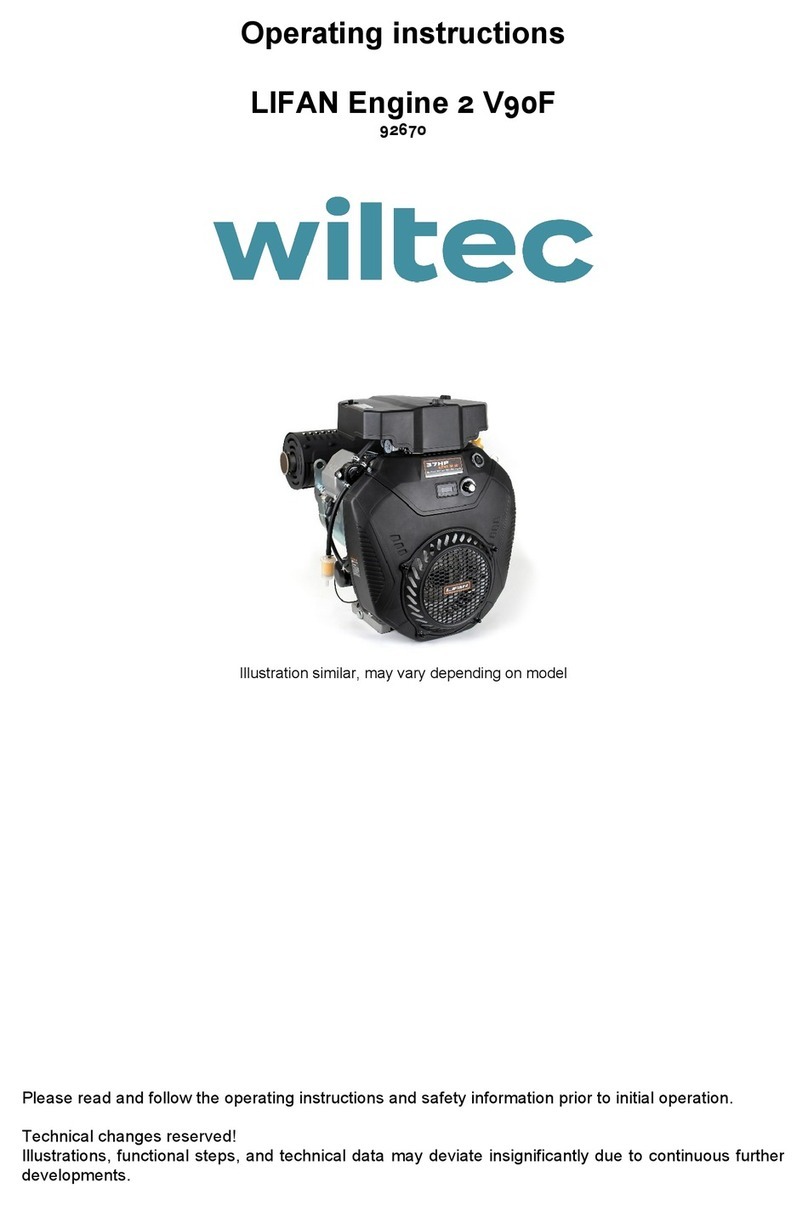
WilTec
WilTec LIFAN 2V90F operating instructions
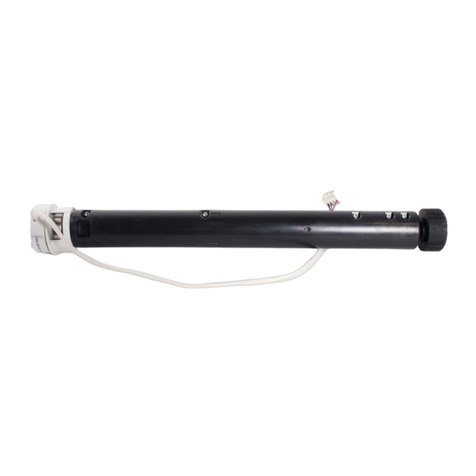
Crestron
Crestron CSM-QMTDC-163 Series installation guide

Motorline professional
Motorline professional KPORTB75 User& installer's manual
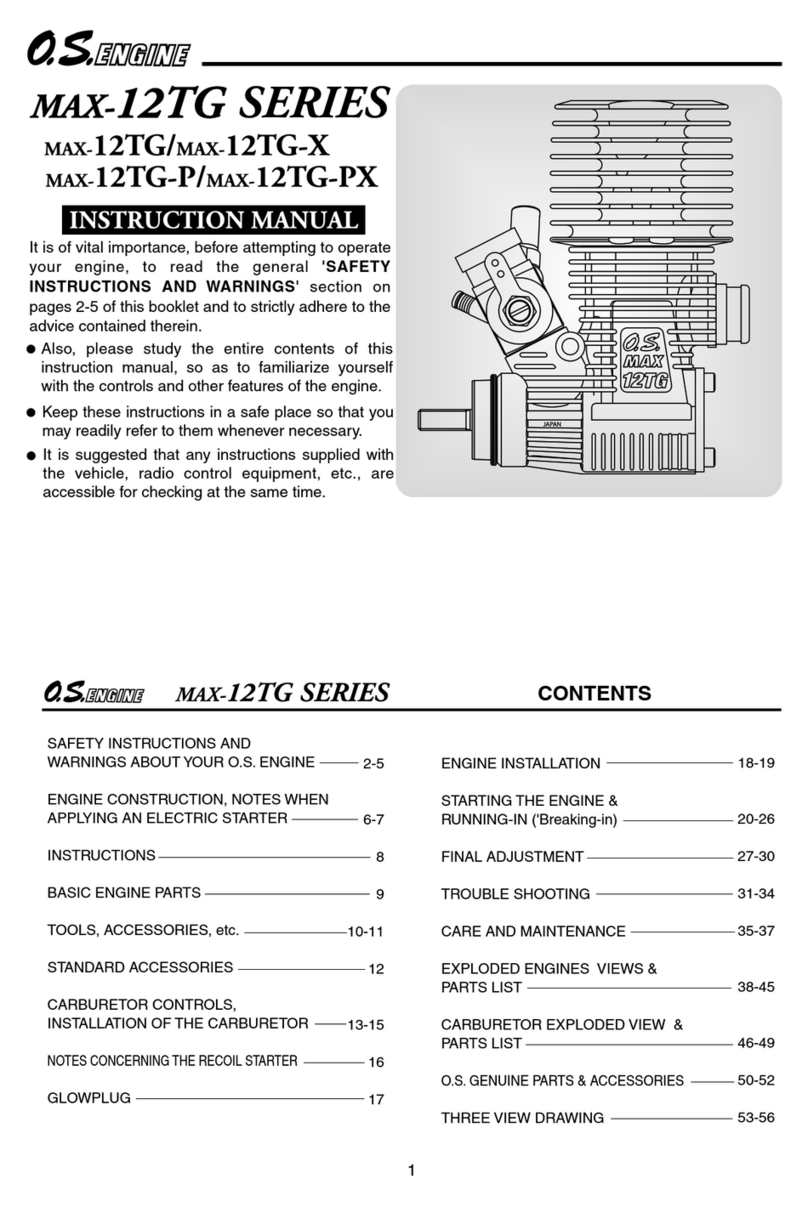
O.S. engine
O.S. engine MAX-12TG-P instruction manual

Baldor
Baldor DSM S Series installation manual
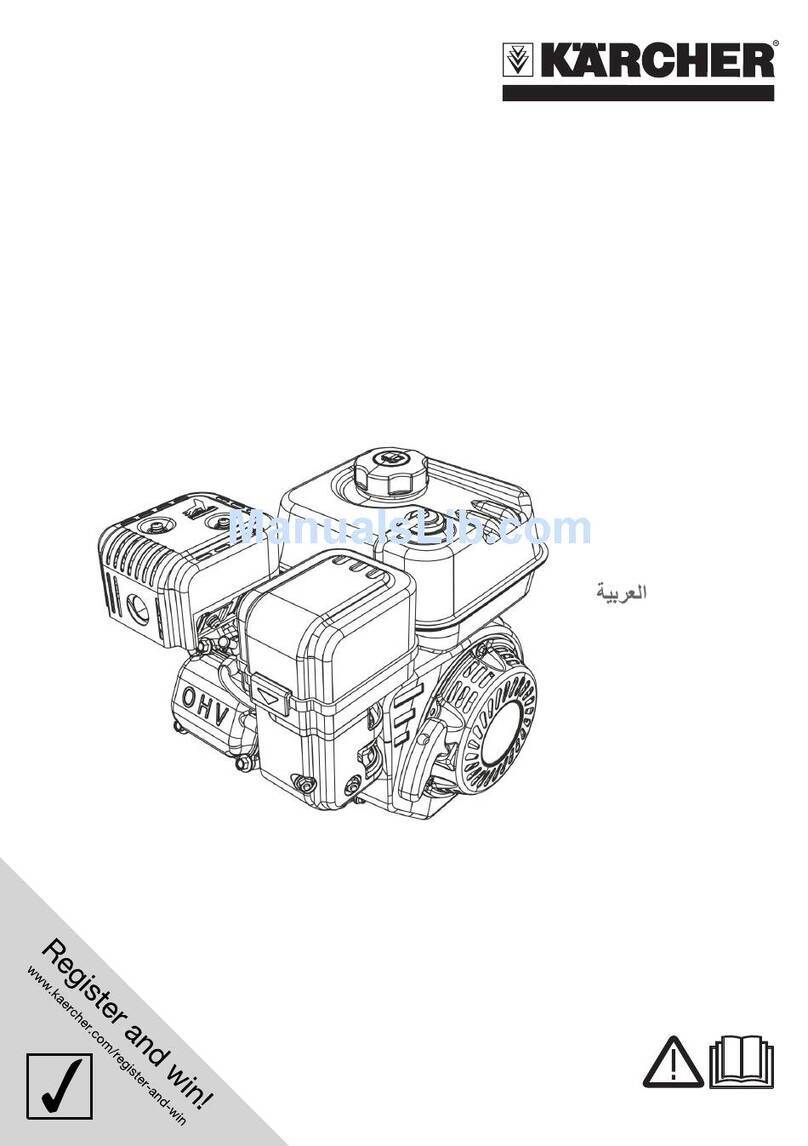
Kärcher
Kärcher G200FA user manual

